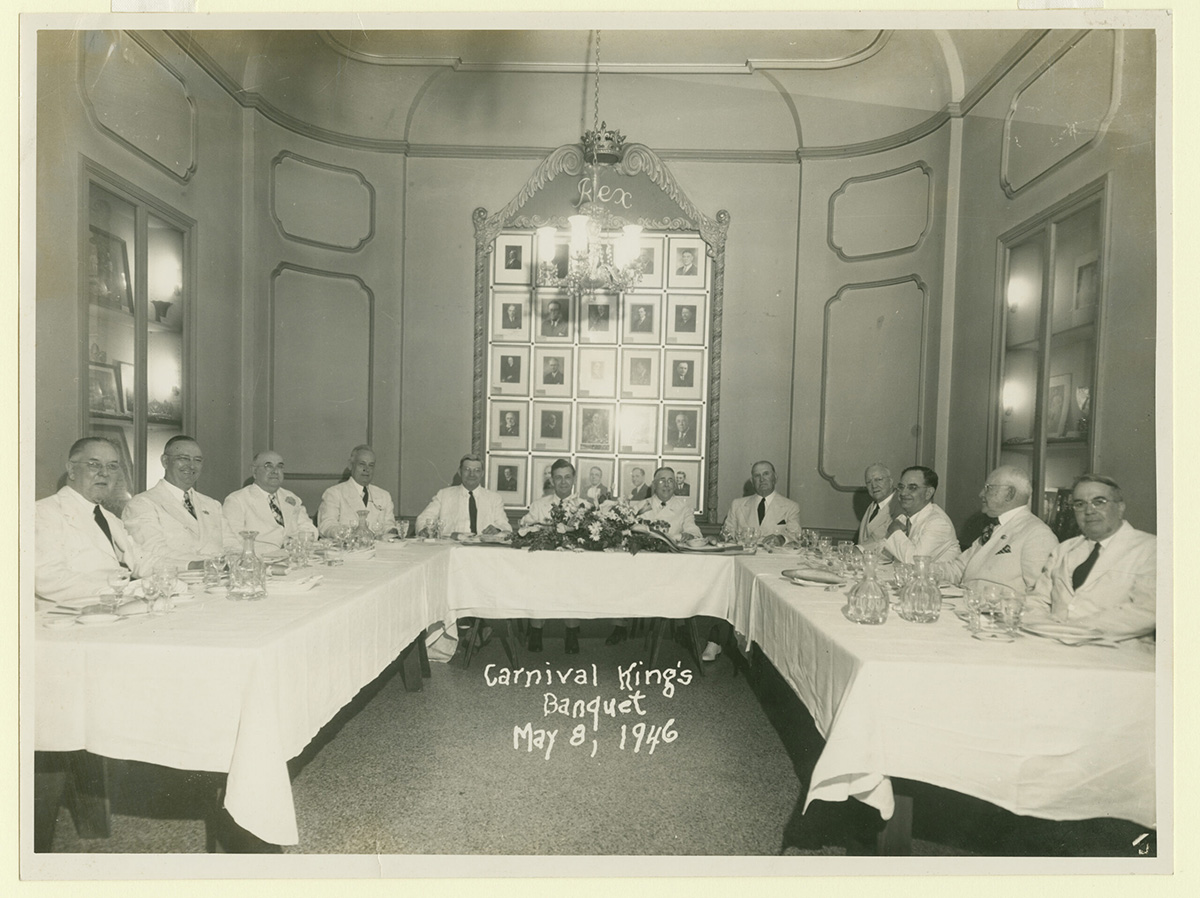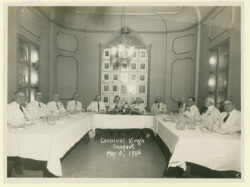Antoine’s Restaurant
Founded in 1840, Antoine’s Restaurant is the oldest continually family-owned and -operated restaurant in the United States.

The Historic New Orleans Collection
Carnival King’s Banquet at Antoine's Restaurant, 1946.
Founded in 1840 Antoine’s Restaurant is the oldest, continually family-owned and -operated restaurant in the United States. Many of today’s classic dishes were created or popularized there, including Oysters Rockefeller and Eggs Sardou, and with every flaming Baked Alaska and Café Brulot, food traditions of past centuries are reverently perpetuated. The story of Antoine’s belongs not only to the Alciatore family but also to the generations of devoted employees and diners who treasure the venerable establishment.
Restaurant Beginnings
Antoine Alciatore was born in Alassio, Italy, in 1822 but moved to France with his family during his childhood. At the age of twelve, Alciatore began his apprenticeship at the Hotel de Noailles in Nice, France, and later apprenticed with French chef Jean-Louis Françoise-Collinet. During this time it is believed Alciatore was present when soufflé potatoes were first created, a dish which continues to be a mainstay of Antoine’s menu today. The twice fried potato slices puff during a second frying, setting them apart from pommes frites, the traditional French fry.
Alciatore entered the United States through New York City, but his arrival date in New Orleans is unclear. In 1855 he married Alsatian-born Julie Freysz in New Orleans. The couple’s first pension and restaurant were situated at 50 St. Louis Street. In 1868 they moved to 713 St. Louis Street where the restaurant operates today.
In 1877 ill with lung disease, Alciatore returned to Marseilles, France, to see his mother and died three months later. Madame Alciatore, now “The Widow Antoine,” managed the business with family help. Her eldest son Alexandre managed the dining room. Brothers Fernand and Jules pursued culinary apprenticeships abroad.
Jules returned to New Orleans initially serving as chef at the exclusive Pickwick Club, where he gained a name for himself with the city’s elite. In 1894 Jules married Althea Roy, daughter of a wealthy planter from Youngsville. Purchasing Antoine’s Restaurant from his aging mother with Althea’s dowry, he became sole proprietor, securing its future.
Jules acquired adjoining buildings, constructing two large banquet halls. Accommodating up to seven hundred guests, “Antoine’s Annex” was advertised for banquets, dinner dances, and after-theatre supper dances.
Expansion and Refinement
As Antoine’s expanded in the 1890s, Jules grew the wait staff by recruiting French-speaking Cajuns from nearby southwest Louisiana, training them to serve impeccably. At least three years of preparation were required to wait tables. Many worked as busboys for a decade before making direct contact with guests. Succeeding generations followed in their Cajun fathers’ and uncles’ footsteps by passing on their “preferees,” or preferred client lists. By the 1970s New Orleans families with their “own” Antoine’s waiter made reservations directly with them, avoiding the line waiting outside the restaurant. Women and people of color did not work in the front of the house until the late twentieth century.
Jules shared the culinary brilliance of his father Antoine. Many of today’s classic dishes were created during his tenure there. A French snail shortage in 1899 inspired Oysters Rockefeller. Using the escargot’s bourguignonne sauce as a base, Jules added a still-secret combination of eighteen ingredients to the garlic butter compound, resulting in a bright-green topping for baked oysters. It is said that the first person to taste the new dish exclaimed, “This is as rich as Rockefeller,” a reference to the richest man in America at the time.
Jules made a significant contribution to the canon of New Orleans egg dishes with Eggs Sardou. First served at a late-night breakfast honoring French actress Sarah Bernhardt, his creation was intended to be named for the “Divine Sarah,” but she insisted the honor go to French playwright Victorien Sardou because of the plays he had written for her. Comprised of anchovies crossed over an artichoke bottom, topped with a poached egg and hollandaise sauce, garnished with chopped ham and sliced truffles, the original does not include creamed spinach as commonly seen today. Jules also popularized the flaming after-dinner coffee Café Brulot Diabolique. Brandy and triple sec are flamed in a silver bowl containing cinnamon sticks, citrus peels, cloves, and sugar, with chicory coffee extinguishing the fire.
Roy, Jules and Althea’s youngest child, began working at Antoine’s in 1917 at age fourteen. Growing up, Roy accompanied his father on frequent European excursions to learn about food and wine. By 1933 Jules advertised his son Roy as Antoine’s “proprietor and manager.” Jules died less than a year later.
Following his father’s death Roy planned for Antoine’s centennial celebration in 1940. Undertaking a post-Prohibition rebuilding of Antoine’s wine cellar, he focused on American wines, the first such list seen in US restaurants. The official celebration was held on April 3, 1940. The $25,000 that Roy invested paid off handsomely as media across the nation noted the restaurant’s landmark anniversary.
When Antoine’s frequent patron, Frances Parkinson Keyes, proposed Dinner at Antoine’s as the title of her next book, Roy became an eager collaborator. Typed manuscript drafts passed between them, and when the novel was published in 1948, Roy hosted a private dinner for more than two hundred guests at the restaurant.
Roy created the tradition of Antoine’s “Krewe Rooms,” beginning with New Orleans’s Carnival king, Rex. Mardi Gras’s old-line secret societies vied for their own dining room at Antoine’s. Roy happily complied. Each of the rooms features lighted, glass cases displaying trappings of Mardi Gras royalty. Ball gowns, tiaras, and scepters of past queens are featured along with “ducals,” ball invitations, and other Mardi Gras favors. Photos of past courts line the walls, lending New Orleans’s high society a sense of ownership of the venerable establishment.
Restaurant Transitions
By the 1960s Roy’s nephews, William and Roy Guste, became increasingly involved with the business. When Roy succumbed to colon cancer in 1972, the restaurant’s management fell to his nephews’ sons, Roy Jr. and Bernard Guste. During the turbulent 1980s and ’90s, Antoine’s formality seemed out of step with the world, and the restaurant struggled financially.
In 2004, when Roy Alciatore’s daughter Yvonne Blount and her family learned the full extent of Antoine’s physical and financial condition, a deal was struck giving full ownership to the Blounts. Yvonne’s eldest son Rick assumed full management less than a year before Hurricane Katrina caused extensive damage to the restaurant. Heroically Rick Blount managed to reopen the historic restaurant on December 31, 2005. In 2009 the Hermes Bar, Antoine’s first casual spot opened. Yvonne Alciatore Blount died in 2022. Her son Rick continues to manage the family business.
